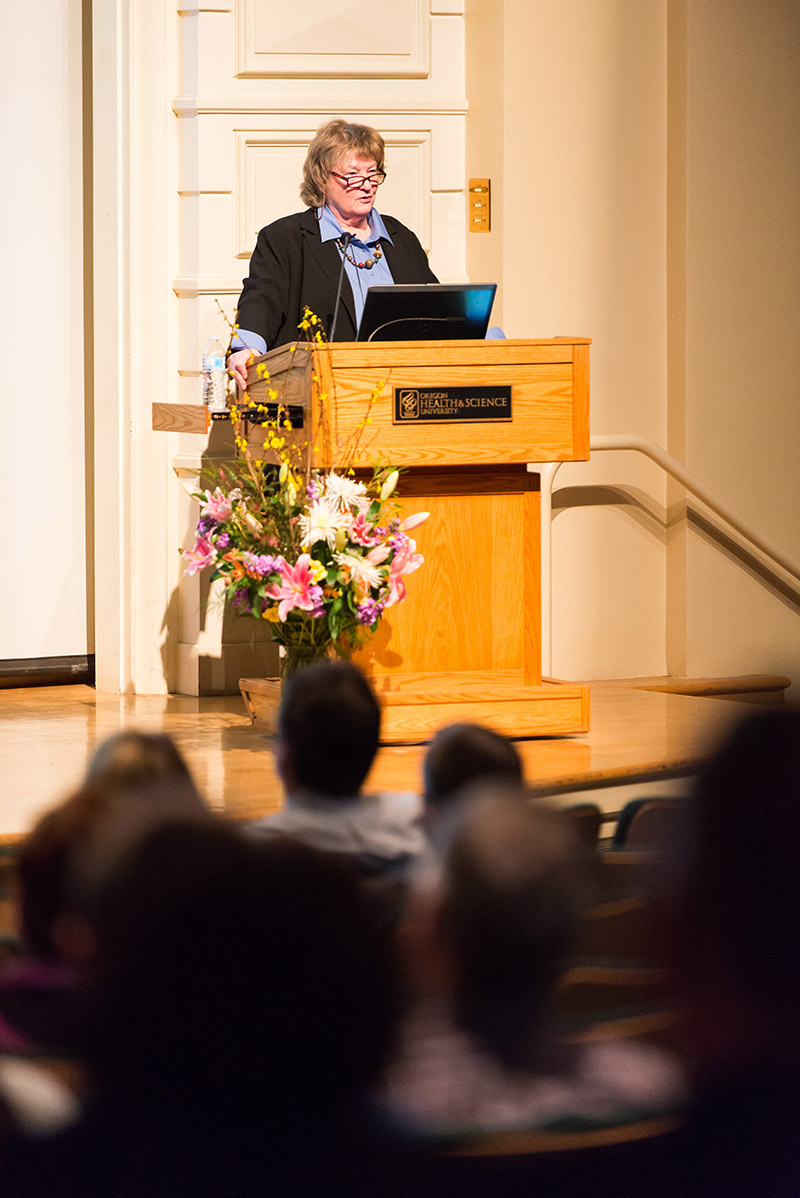State of the School: Annual Faculty Meeting 2018 | School of Medicine

Feb. 14, 2018
In the plainspoken tradition of academicians, Dean Sharon Anderson used her first State of the School Address to tell the story of a thriving School of Medicine, confronting the challenges of modern health care and biomedical science while speaking truth to power in an era of external threats that are driving OHSU to double down on our values.
"We do great work, and we do lots of it," Dr. Anderson said, summing up the Herculean lift of OHSU's largest school in which its faculty fuels the clinical enterprise, including OHSU Hospital, ranked #1 in Oregon by U.S. News & World Report; its scientists, centers and institutes comprise two-thirds of the OHSU research portfolio, chosen among the Top 20 in innovation by Nature magazine; and its education programs are nationally recognized and headed by leaders in curriculum reform.
Reforming education for today's workforce needs
Dr. Anderson highlighted the competency-based M.D. curriculum that this spring will graduate its first four-year cohort with U.S. Medical Licensing Examination test scores showing skill mastery despite an accelerated path from classroom to clinic.
She touched on the Ph.D. program transformation underway to create more flexible, interdisciplinary programs designed to catalyze discovery and better prepare the next generation of biomedical scientists for a changing career landscape.
And she extolled the accomplishments of the Physician Assistant program. Ranked fifth in the nation by U.S. News &World Report, 35 percent of the 26-month program's incoming class is under-represented minorities, 24 percent are from rural areas and 23 percent of its 600 alumni practice in rural areas, many in primary care.
"Our P.A. graduates are helping us with future workforce needs, filling gaps throughout the state," Dr. Anderson said.
She lingered on the expansion of the Graduate Medical Education program. OHSU plans to create as many as 100 new residency slots across the state in coming years to meet physician workforce needs and unpack the bottleneck created when insufficient slots exist to accommodate the number of students graduating from medical school. The expansion begins at Tuality Healthcare, the flagship of the evolving OHSU health system.
Nationally recognized research driven by collaboration
In the research mission, she highlighted the just-released Blue Ridge rankings. This prestigious measure of National Institutes of Health funding shows many OHSU standouts. She also noted the rankings' flaws. OHSU's formidable neuroscience program, for example, fails to rate because of the way the discipline is structured at OHSU.
She called out the Veterans Affairs Portland Health Care System, ranked sixth in the country in research funding, and the team science and collaborative nature of research in the School of Medicine and across OHSU.
And she announced the expansion of OHSU's partnership with the Pacific Northwest National Laboratory to advance precision medicine.
"We're getting terrific people together to get great stuff done," Dr. Anderson said.
Expansion and access in the clinical enterprise
In the clinical mission, she highlighted OHSU's improved visibility in national quality and safety rankings, including being named #12 in the 2017 Vizient Quality and Accountability Study.
She described the clinical mission's efforts to improve access, such as through the new OHSU Mission Control in which a high-tech dashboard helps OHSU systematically identify open beds and ease the process of placing transfer patients into OHSU settings –for the right care, at the right time, in the right place. "We're looking at all kinds of ways to find places for our patients to be," she said.
She touched on challenges across missions, from declining T-32 grants to continued challenges in the clinical enterprise because OHSU has insufficient beds to meet demand.
Areas of focus: from compensation to advocacy
She highlighted key initiatives underway from a focus on recruitment and retention of physician scientists to aligning faculty productivity, compensation and incentives, to efforts to create a comprehensive and coherent approach to faculty development and wellness.
"My goal would be to have every faculty member understand where his or her salary is coming from, what the components are and what they need to be doing," she said.
Dean Anderson emphasized the importance of the OHSU Unconscious Bias Initiative, led by the Center for Diversity and Inclusion, to help OHSU become not only diverse but a more welcoming and inclusive environment. And she recognized students and faculty, including Esther Choo, M.D., M.P.H., associate professor of emergency medicine, OHSU School of Medicine, for speaking out when our values are challenged or practices or behaviors harm others.
"If you see something, say something," she said.
She ended with what she described as her best day so far as dean, Aug. 21, 2017, the day of the total eclipse of the sun.
"It allowed all of us to step away from our busy, crazy jobs to just go outside and look up at the sky," she said. "It was uplifting in more ways than one."